The Gooty Sapphire Tarantula, also known by its scientific name, Poecilotheria Metallica, is an Old World Arboreal species that is native to India.
There are over 800 identified tarantula species and the GST is often considered to be the most beautiful of them all. It has intricate patterns and stunning blue, yellow, and sometimes white colorations.
Because of this, the animal is highly desired among hobbyists and pet owners and is often considered the crown jewel of many tarantula collections.
However, while these spiders are definitely very beautiful, they’re not the most beginner-friendly species. They’re fast, highly venomous, and quite defensive.
For that reason, it’s all the more important that you learn as much as you can about this magnificent animal before you decide that you’re ready to take on the responsibility of taking care of one.
That’s what this guide is aimed at. I will give you a complete overview of everything you need to know about this spider so that you can make an informed decision on whether or not you’re ready to get caught in the web and take care of one of these beautiful spiders.
If you’re considering adding the Gooty Sapphire Tarantula to your collection you’ve come to the right place because I’ll tell you everything you need to know about these beauties!
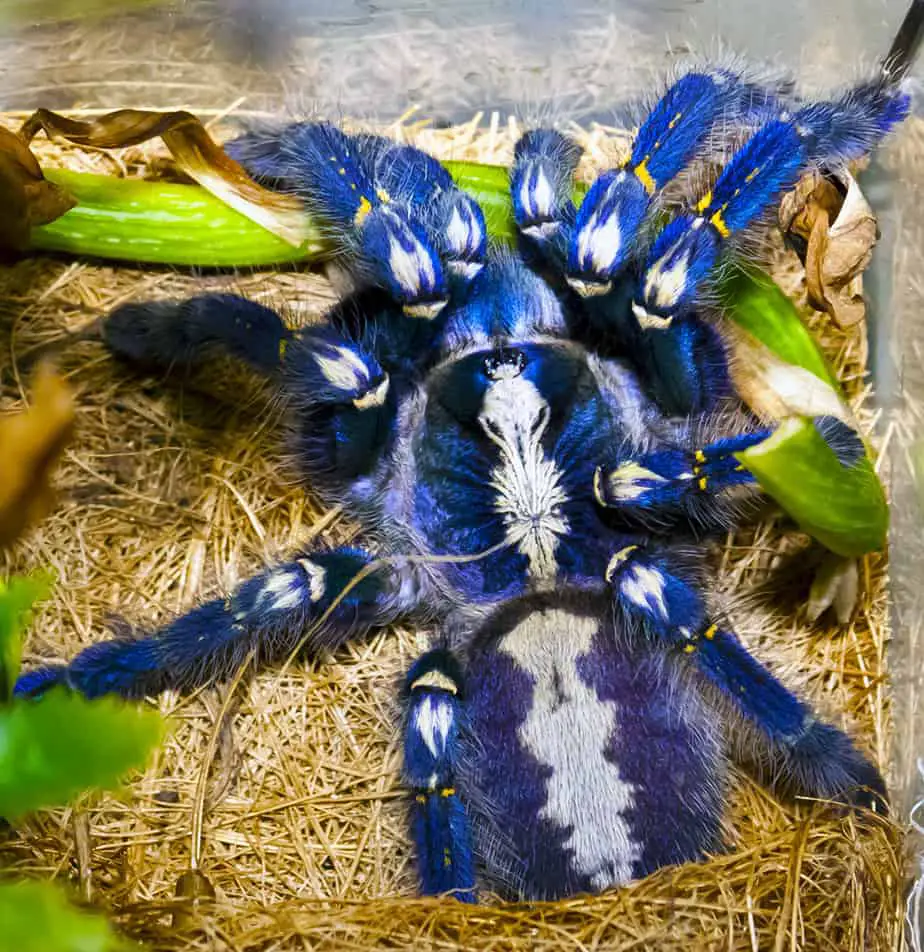

Gooty Sapphire Tarantula Care Sheet
| Species Name | Poecilotheria Metallica |
| Family Name | Theraphosidae |
| Common Name | Gooty Sapphire Tarantula |
| Category | Old World |
| Type | Arboreal |
| Native Location | India |
| Leg Span | 6 to 8 inches (15 to 20 cm) |
| Growth Speed | Fast |
| Urticating Hairs | No |
| Social | Solitary |
| Diet | Insects: crickets, roaches, mealworms |
| Temperature | 78°F to 82°F (25.5C° to 27.8°C) |
| Humidity | 65 to 75% |
| Life Expectancy | Female: 12 to 15 years / Male: 4 years |
| Experience required | Advanced |
| Minimum tank size | 5 Gallons. |
Gooty Sapphire Tarantula Overview
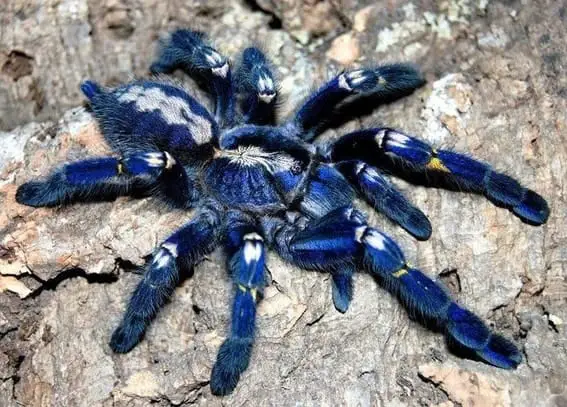
The Gooty Sapphire Tarantula, scientifically known as the Poecilotheria Metallica is an Old World Tarantula that’s native to India.
This spider was first found in India in 1899 near the town of “Gooty”, which is where the spider derives its name from. Interestingly enough, the spider was lost for a very long time, only to be rediscovered as recently as 2001. It was rediscovered in Andhra Pradesh, far away from the location of its original discovery.
It is speculated that the spider’s native habitat is in Andhra Pradesh and that it was a stowaway on a cart or a ship and ended up in Gooty that way.
That would explain why it was lost for such a long time. Unfortunately, much of the Gooty Sapphire Tarantula’s habitat is being destroyed which makes it a critically endangered species.
Because of this, it’s illegal to remove it from its habitat and export it.
However, this does not mean that it’s illegal to buy them. Since they’re already kept in captivity in many other countries, such as the United States and Europe, they’re bred there and can be legally sold and bought.
Behavior & Temperament
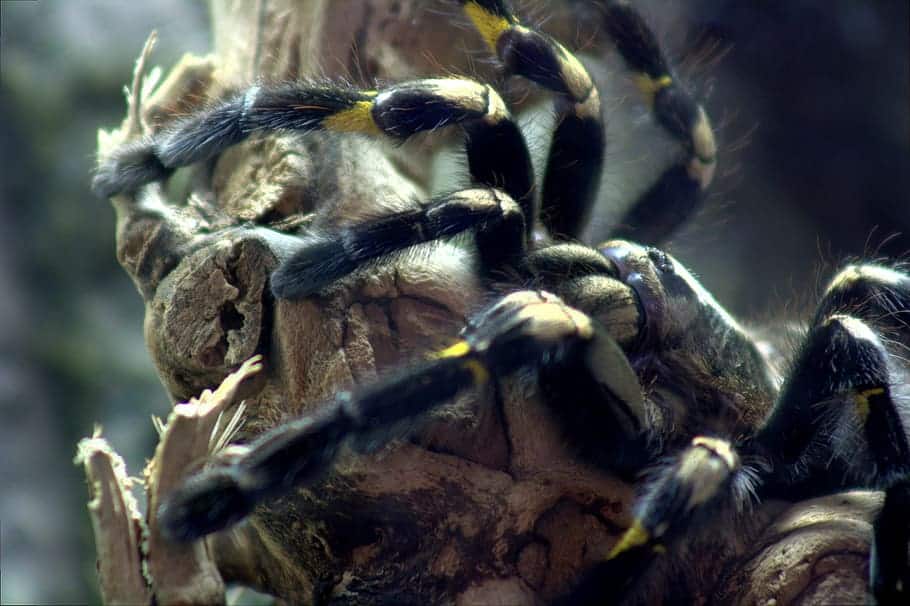
The Gooty Sapphire Tarantula is not as defensive as other species from the Poecilotheria genus but they’re still not docile.
They prefer to run from danger rather than fight it, but they are definitely capable of biting if they feel the need to. Before they bite, they tend to strike a threat posture.
If you notice this behavior, it’s best to give them some space because they are highly venomous. It’s one of the main reasons why they are not a beginner-friendly species.
In contrast to New World species which are not very dangerous and have mild Venom, the P. Metallica has relatively powerful venom.
Their venom is not lethal if you’re not allergic, but it can cause intense pain, sweating, headache, stinging, cramping, or swelling.
Also, in contrast to the bites of many other species, the effects can sometimes be felt months later.
Luckily, most of their bites are dry (meaning they do not inject venom).
Nevertheless, even the dry bites are no joke because they have formidable fangs. Their fangs can grow up to 3/4 of an inch in length and can inflict serious damage.
Luckily, biting is only used as a defense of last resort. They do not bite humans out of nowhere and will give plenty of warning signs. If you treat them with the respect they deserve, you can easily avoid getting a taste of their fangs.
They also tend to spend quite a bit of time out in the open, which combined with their beautiful blue coloration makes them a stunning show spider.
Gooty Sapphire Tarantula Price
The Metallica used to be quite an expensive spider. In the past, a single spiderling could cost upwards of $500.
Their high cost was mainly due to the fact that they were in such high demand combined with the fact that they were quite rare.
However, breeders quickly realized that they could make a lot of profit by breeding these spiders and as a result, the supply has caught up with the demand.
Because of this, these tarantulas are not all that expensive anymore.
Nowadays, you can buy a Gooty Sapphire Tarantula spiderling for around $75 from a breeder. Females are generally more expensive than males because they have a much longer lifespan.
Appearance & Variants
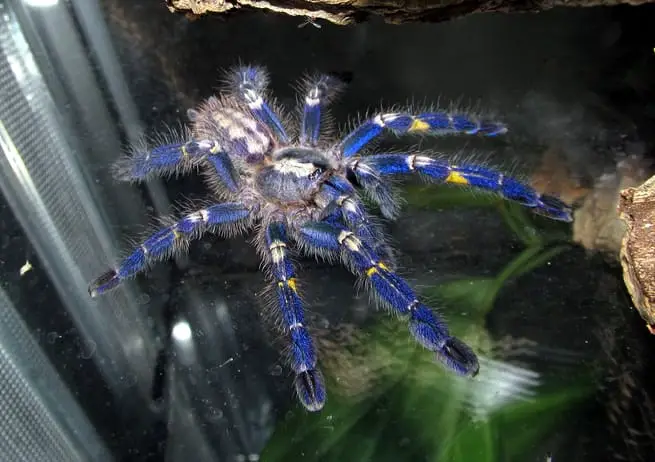
The Gooty Sapphire Tarantula is most famous for its stunning colors. If you ask 100 hobbyists which spider is the most beautiful, I have a strong belief that this spider will top the list.
They have a stunning blue color all over their legs, abdomen, carapace, and pedipalps. In addition, they have yellow and white spots on their legs and a striking white pattern that adorns their carapace and abdomen.
Slings of this species are much less chromatic. They don’t get their full characteristic coloration until they’re fully grown.
These spiders are sexually dimorphic which means that males look different from females. The primary difference is in their size. Males are quite a bit smaller and have much slenderer bodies with legs that are longer relative to their size. In addition, they are often much duller in color than the more brightly colored females.
As spiderlings, they are around an inch in size. However, they grow fast. A fully grown female has a leg span of 6 to 8 inches which is quite large for a tarantula.
They can also be quite heavy, and fully grown, they can weigh as much as a mouse.
Caring for a Gooty Sapphire Tarantula
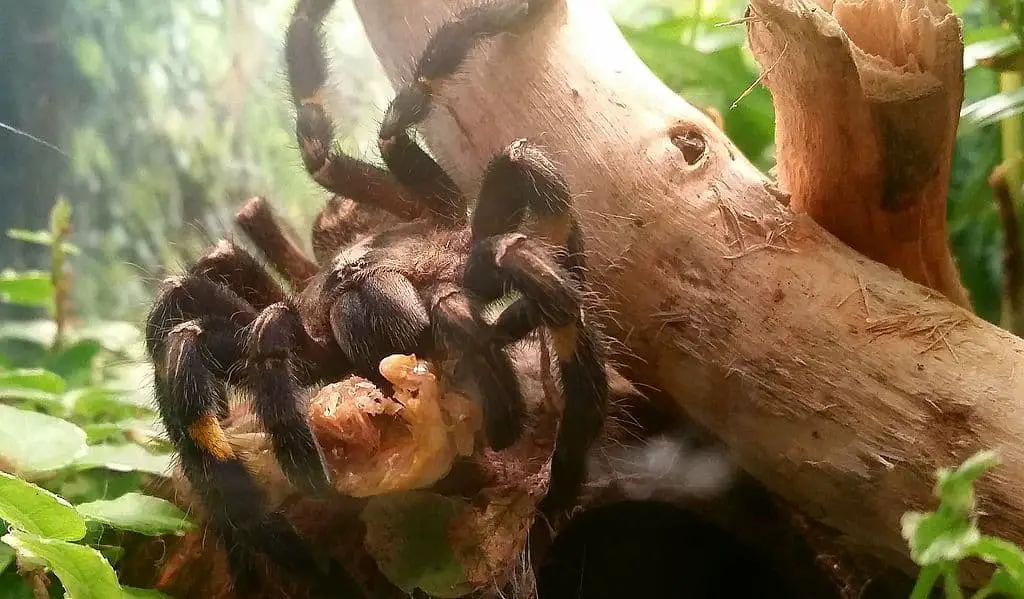
Feeding
The Gooty Sapphire is a carnivore. It doesn’t eat any plants and it has a diet that consists almost entirely of insects, mostly crickets, grasshoppers, moths, or mealworms.
When they are small, make sure that you give them small insects, otherwise, they might not be able to eat them. Flightless fruit flies or cricket legs are a good choice.
Once they grow larger you can move on to live feeding with insects that grow larger as the spider increases in size. Make sure that you do not feed them anything that’s larger than their abdomen.
Some owners choose to gut-load the insects they feed their spiders. Gut loading is the process of feeding the insects a nutritious diet with the intention of passing these nutrients to the spider. It’s not absolutely necessary, but can be beneficial.
Tarantulas like to catch their prey themselves, so it’s a good idea to give them live insects rather than dead ones. In fact, they might not even eat the insects if you offer them frozen or dead.
Generally speaking, adults should eat 4 to 5 large crickets every 10 to 14 days. However, the amount they should eat does depend on their size. Larger specimens will need to eat more, so try to experiment with how much you feed them.
Drinking
Tarantulas can go a long time without food, but the same can not be said about water.
They need to drink daily, so make sure that they always have access to a fresh source of water. Tarantulas can only drink water, so do not try to give them anything else.
Ideally, you should change the water every day so that it does not get dirty.
Make sure that their water bowl is shallow so that they can not accidentally drown themselves in the water.
Tank setup
Since these animals are from forests in India it’s best to imitate their natural habitat as closely as you can.
Also, since these animals can grow quite large it’s essential that you give them an enclosure that’s large enough to house them.
However, while these spiders can grow to quite a large size, they do not need a huge enclosure. They might grow big, but tarantulas do not move around very much.
They’re stationary a lot of the time to conserve energy. Therefore, a 5-gallon tank is big enough for them.
Height is more important than width and length in this case. The reason for this is that their enclosure will need to be tall enough to fit a vertical hide.
Since these are arboreal spiders, I highly recommend trying to simulate a tree in their enclosure. Take a look at this video to see what I mean:
Instead of focusing on having a large enclosure, it’s much more important to get the other things right, such as temperature, humidity, and substrate.
Temperature
The Gooty Sapphire Tarantula thrives at a constant temperature of 78 to 82 degrees Fahrenheit. This temperature is close to what they’re used to in the wild and is what they’re best adapted to.
Warmer temperatures can contribute to faster growth, but are not necessary.
Humidity
In order to get the perfect humidity, we should look at the spider’s natural habitat and simulate that as closely as we can.
In its natural environment, this tarantula lives in a place where the humidity is around 70-80% so it’s best to aim for the same humidity level in their enclosure.
One thing to be careful of is that at such high humidity levels it’s very possible for bacteria and mold to start growing which is obviously not good.
To prevent this from happening, it’s essential that their tank has good ventilation.
Reaching the desired humidity level is different for everyone and highly depends on where you live.
If you live in a place with high relative humidity it will be easier to achieve the desired humidity level than when you live in a place with low humidity.
Some tips to increase the humidity levels are to use evaporation from a water bowl (make sure the bowl is shallow so the spider doesn’t accidentally drown) and to use a water spray bottle to increase the humidity when it gets too low. Watering the substrate is also a good way to increase the humidity in their enclosure.
To check the humidity levels, it’s useful to get a hygrometer.
Substrate
The Gooty Sapphire tarantula is not a burrowing spider, so you do not need a special substrate that allows them to burrow. Nevertheless, a layer of substrate of about 2 inches thick is recommended.
The best kind of substrate to go with is a mixture of coconut fiber, peat moss, sphagnum moss, and vermiculite. It’s great at retaining moisture which can help keep the climate pleasant for your spider.
Social
Some tarantula species are capable of communal living and the Gooty Sapphire is one of them! They can get along with other members of their species and live in the same enclosure without resorting to cannibalism.
This is quite unique because out of the more than 800 species, there are only a few with whom this is possible.
So, if one GST is not enough for you, you can get more than one and house them together.
Handling the Gooty Sapphire Tarantula
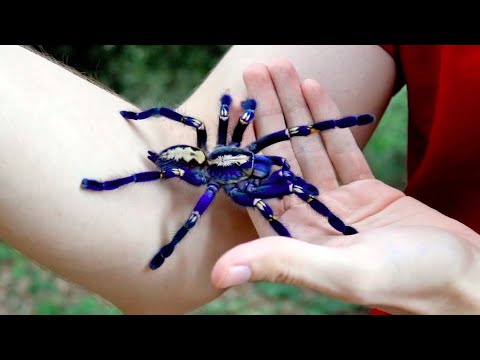
These spiders are very fast and are not easy to handle. In fact, while some tarantulas will gladly crawl on your hand, and are quite docile, this is not the case with the Gooty Sapphire Tarantula.
I’ve already touched upon the fact that these spiders are venomous and that their bite can inflict some serious damage. On top of that, they’re quite easily spooked if they feel threatened they might try to run away and fall from your hand which can seriously harm the spider.
There are videos out there of people handling the Gooty Sapphire, but personally, it’s not a risk I’d recommend you to take, especially if you’ve never handled a Metallica before. Especially because tarantulas do not really enjoy being handled in the first place.
It’s better to admire the spider from a distance rather than let it crawl on top of you. If you do decide to handle this spider, be very careful. Take note of their posturing and behavior.
Do not make any sudden movements and do not breathe on them because this can provoke a painful bite.
Molting
All tarantulas molt and this species is no exception. Molting is the process of shedding the exoskeleton and growing a new one. The new exoskeleton is soft at the start and hardens over time. They are very vulnerable during this period because of how soft and sensitive their new exoskeleton is.
Young tarantulas will molt quite often because they’re still growing and need a bigger exoskeleton to accommodate their larger size.
Once they’re fully grown, they will molt around once a year. These spiders usually molt laying on their back, so if you see them laying on their back when it’s time to molt, do not be alarmed and try not to disturb them.
Make sure that you do not feed them for several days after they molt because their fangs need time to harden before they can eat.
Lifespan & Health
These tarantulas have a very long lifespan, especially the females. In rare cases, a female Metallica can live for up to 15 years in captivity but they usually live for up to 12 years. The males have a much shorter lifespan at around 4 years.
This is important to consider – if you’re going to get a Gooty you have to make sure that you’re capable of taking care of it for years.
They can easily live out their full lifespan in captivity because they’re hardy spiders that don’t have much to fear in their enclosure. To keep them healthy, make sure that you keep their enclosure clean to prevent bacterial growth and spider mites.
In addition, make sure that you only feed them captive-bred insects. Wild-caught insects can have parasites, which can spread to your spider.
Lastly, make sure that you are careful when handling them so that you do not drop them.
Breeding Gooty Sapphire Tarantulas
The Gooty Sapphire only mates once per year and they’re not ready to mate until they’re 2 to 3 years of age. When the male is ready to mate, he will produce a sperm sack which he will carry with him until he finds a female. The females simply wait for the suitor to arrive. They typically mate in the summer.
If you want two of these spiders to mate, you should introduce them to one another in a small cage, forcing them to be together. But, be careful, female Gooty Sapphires are notorious for killing and eating males before they have a chance to mate.
One of the most important things to take care of before introducing the male and female is making sure that both are well-fed. A well-fed spider is much less likely to attack and much more likely to be willing to mate.
Once they have been introduced and the male has successfully mated with the female, the female spider will start to produce eggs in an egg sack. She will carry this egg sack on her back for 1 to 8 months, depending on the environment. During this time, the female needs to be fed more often because she needs more energy.
There can be up to 1000 eggs in this egg sac. Not all of them will turn into spiderlings, but the ones that do, you can sell. They can go for quite a decent price. Nevertheless, if you’re aspiring to become a tarantula breeder it’s essential that you do a lot of research and planning and don’t go into it blindly.
Otherwise, if you do not plan it right, you might get stuck with many small spiders and no buyers.
Gooty Sapphire Tarantulas for sale
If you’re wondering where you can buy one of these beautiful blue tarantulas, your best bet is to go with a breeder. Here are some websites that might have them for sale.
Gooty Sapphire Tarantula Facts
- It is believed that their bright color is used to compete for mating and breeding
- They’re also known as the metallic tarantula, peacock parachute spider, or peacock tarantula
- Their colors change when viewed from different angles
- They’re avid webbers that create stunning funnel webs.
- The P. Metallica is endangered which is why it’s very important to only buy them captive-bred to avoid supporting poachers

Final words
The Gooty Sapphire Tarantula is definitely at the top of my list of most beautiful species. Their stunning coloration combined with the fact that they can live communally truly makes these spiders some of the most unique species on the planet. It’s easy to see why they’re considered the crown jewel of many collections.
However, if you’re new to the hobby and this species has caught your eye, I do recommend getting your feet wet with some docile New World species first, such as the Mexican Red Knee or the Antilles Pink Toe.
That way, you can learn the ins and outs of tarantula keeping without risking a bite from the P. Metallica’s potent venom.
If you’ve already got a lot of experience under your belt though, you can’t go wrong by picking up one of these beauties!
- How Long Do American Eskimo Dogs Live? Important Factors and Care Tips - September 29, 2023
- Do American Bulldogs Need Grooming? Essential Tips and Care Guidelines - September 29, 2023
- Do Bengal Cats Enjoy Playing? Essential Tips for Keeping Them Active - September 29, 2023